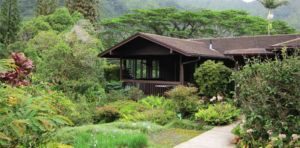Gardens and Features
Nestled deep in Mānoa Valley and with an average annual rainfall of 165 inches, Lyon Arboretum’s 194 acres boast a collection of 5,660 thriving tropical plant taxa.
Descriptions of some of our gardens and features can be found below.
You can also visit our maps page.

A black arrow next to a heading indicates that that section can be hidden from view; just click the arrow or the heading. Click again to show the section again.
The Visitors Center and Lower Grounds
There are multiple themed and memorial gardens near the Visitors Center. These gardens are easier to access for everyday visitors, and they boast an impressive array of plant life.
The Visitors Center
The Visitors Center
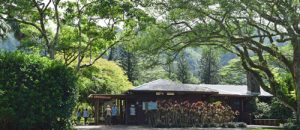
The Lyon Arboretum Visitors Center
We ask all visitors to sign in at the Visitors Center. While there you can pick up a map, visit the bathrooms, and check out our small gift shop. Ask about cool sights or trail closures.
The Stemmermann Memorial Garden and Mapes Memorial Garden
The Stemmermann Memorial Garden and Mapes Memorial Garden
These small gardens are located just outside the Visitors Center. The Stemmermann Memorial Garden offers a wonderful place to sit before embarking on an exploration of our grounds. The Mapes Memorial Garden offers the aesthetics of a Japanese-style garden and features a mixture of ornamental tropical and temperate plants.
- A view of the Mapes Memorial Garden and the Visitors Center
The Young Memorial Garden and Betty Ho Memorial Garden
The Young Memorial Garden and Betty Ho Memorial Garden
This collection of small gardens is located just downhill from the Visitors Center. Betty Ho Memorial Garden is located along the A.D.A. path just downhill from the Visitors Center. The path is lined with a collection of beautiful, antique Chinese pots and a variety of colorful bromeliads. The path leads to the Young Memorial Garden. Sit in the gazebo in the Young Memorial Garden and enjoy the tranquility of our pond.
The Native Hawaiian Garden and the Beatrice H. Krauss Ethnobotanical Garden
The Native Hawaiian Garden and the Beatrice H. Krauss Ethnobotanical Garden
As you leave the Visitors Center, turn right and pass through the courtyard of the Stemmermann Memorial Garden. You will reach an overlook that will give you a view of the Arboretum’s grounds. The path will lead you through the Native Hawaiian Garden, over a small bridge, and into the Beatrice H. Krauss Ethnobotanical Garden.
The Native Hawaiian Garden
The Native Hawaiian Garden
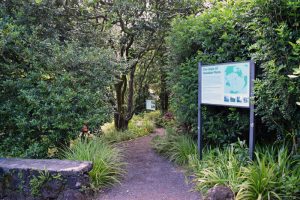
Entrance to the Native Hawaiian Garden
The Native Hawaiian Garden is a collection of indigenous and endemic Hawaiian plants that will grow at the elevation of the Arboretum, approximately 500 feet (152.4 m). It is designed to help visitors to the garden learn to identify native species, and to encourage their use in landscaping. The garden is also an important source of propagation and research material for the Arboretum. Most of the species in the garden were collected from the wild on Oʻahu but a few are from other islands in the chain.
The Beatrice H. Krauss Ethnobotanical Garden
The Beatrice H. Krauss Ethnobotanical Garden

Entrance to the Beatrice H. Krauss Ethnobotanical Garden
The Beatrice H. Krauss Hawaiian Ethnobotanical Garden is designed to showcase those plants that were important in traditional Hawaiian culture, some of which continue to be of great importance today such as kalo (taro) and the many flowering plants used for lei. At present the garden comprises over 60 different species, including the 27 “canoe plants” brought to Hawaiʻi by the Polynesians who settled here over 1,700 years ago.
The Rain Shelter, Walking Buddha Statue, and Bromeliad Garden
The Rain Shelter, Walking Buddha Statue, and Bromeliad Garden
Rain Shelter and Walking Buddha Statue
Rain Shelter and Walking Buddha Statue:
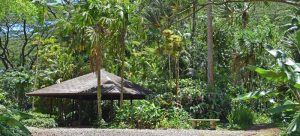
The Rain Shelter
The Rain Shelter and walking Buddha statue are a handy reference point for Lyon Arboretum’s lower grounds. Located near the end of our parking lot, the Rain Shelter offers a pleasant place to sit, rest, and shelter from the rain. The walking Buddha statue is adjacent to the rain shelter.
Paths behind the Rain Shelter lead uphill to the Bromeliad Garden and Inspiration Point. The Main Trail and Larry Helber Palm Walk are downhill from the Rain Shelter.
Bromeliad Garden
Bromeliad Garden
The most famous member of the bromeliad family may be the pineapple, but visitors can see many other examples in the Bromeliad Garden. The patterns and colors of the foliage make this garden a year-round visual delight. The garden is on a slope and is close to both Inspiration Point and the Rain Shelter.



Inspiration Point
Inspiration Point
The slope up to Inspiration Point makes the trail more strenuous than other walks in the Arboretum, but the lush panorama makes the trek worthwhile. If the day is clear and hot, we recommend bringing water, a hat, and maybe even a picnic!
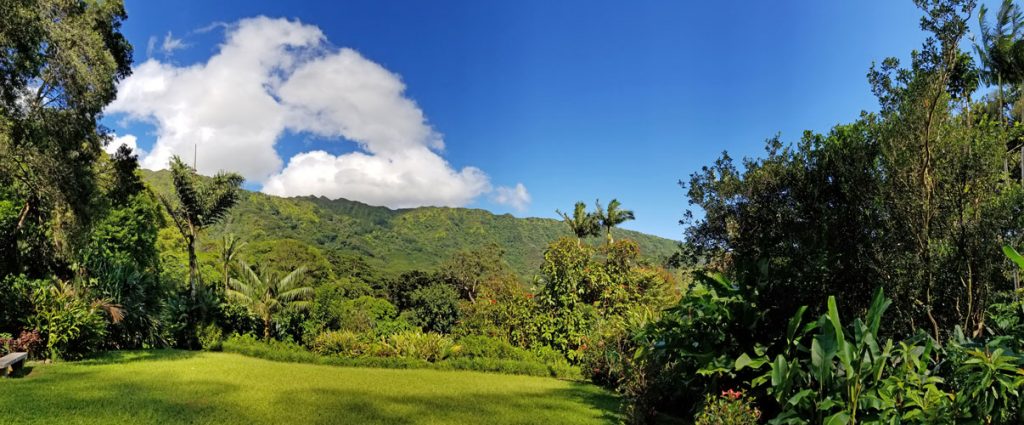
Inspiration Point
The Waterfall
 Although nearby Mānoa Falls is more famous by far, Lyon Arboretum does have its own waterfall: ʻAihualama Falls.
Although nearby Mānoa Falls is more famous by far, Lyon Arboretum does have its own waterfall: ʻAihualama Falls.
Those interested in visiting ʻAihualama Falls can find it by following the Main Trail all the way back into the valley. The trail becomes more rugged farther into the forest, and visitors should wear sturdy footwear suitable for navigating roots and possible mud.
ʻAihualama Falls is relatively dry; unless is has rained recently, visitors should expect very little water flow.
The Upper Grounds
Hawaiian Section
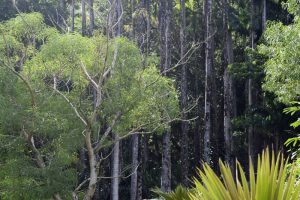 The Hawaiian Section offers a stunning view of upper Mānoa valley and, on a rainy day, the upper sections of Mānoa Falls. This large section exhibits plants native to Hawaiʻi, including many large and mature native trees.
The Hawaiian Section offers a stunning view of upper Mānoa valley and, on a rainy day, the upper sections of Mānoa Falls. This large section exhibits plants native to Hawaiʻi, including many large and mature native trees.
Extensive plantings of the upper reaches of the Hawaiian Section focus on plants native to the Koʻolau, including many loulu (Pritchardia sp.) and koa (Acacia koa). The Hawaiian Section is located off the Main Trail, about midway to ʻAihualama Falls.
Economic Section
The Economic Section, located along the main trail, features tropical trees and plants that are economically important, including trees used for timber, food, and medicine. Trees in the Economic Section include Acai palm (Euterpe oleracea), Cassava (Manihot esculenta), Durian (Durio zibethinus), Lipstick plant (Bixa orellana) and many others interesting and economically significant plants.
Virtual Tour
We invite you to explore our virtual tours.
Before you head out
Check out our Safety and Policies page
Things to bring
- Sturdy shoes
- Water bottle
- Bug spray
- Raincoat
- Hat
- Sunscreen
- Snacks, camera
Things to leave at home
- Pets (only trained service dogs are permitted in the Arboretum)
- Drones
- Bathing suit


